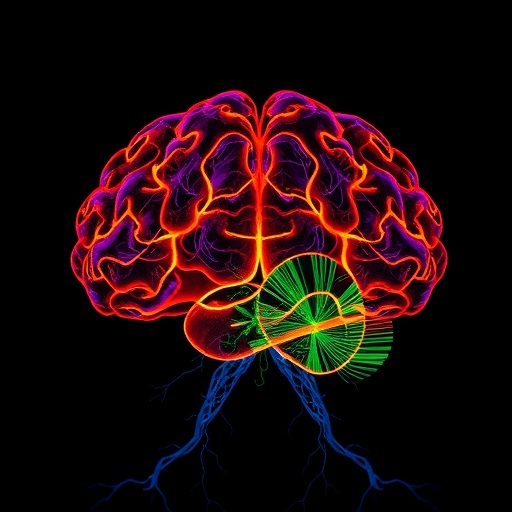In a groundbreaking study poised to redefine our understanding of metabolic regulation, researchers at the Institute of Genetics and Developmental Biology, part of the Chinese Academy of Sciences, have unveiled a previously unrecognized population of hypothalamic neurons that serve as crucial controllers of energy expenditure. This pivotal discovery not only enhances our grasp of the intricate neural mechanisms governing metabolic homeostasis but also suggests innovative therapeutic pathways against obesity and its associated metabolic disorders, which remain paramount challenges in global health.
Traditionally, the hypothalamic arcuate nucleus (ARC) has been the focus of metabolic regulation studies, primarily spotlighting two dominant neuronal populations: pro-opiomelanocortin (POMC) neurons, which promote energy expenditure and suppress appetite, and agouti-related peptide (AgRP) neurons, which stimulate food intake and conserve energy. However, these neurons alone have failed to elucidate the full complexity underlying energy balance, particularly the mechanisms orchestrating energy consumption independent of caloric intake. Addressing this gap, the team employed state-of-the-art single-cell transcriptomics and in situ hybridization methods to conduct a comprehensive molecular dissection of ARC neuron subtypes.
Their meticulous analyses led to the identification of a novel GABAergic neuronal subset distinguished by robust expression of cellular retinoic acid-binding protein 1 (Crabp1). Unlike POMC and AgRP neurons, Crabp1 neurons exhibit unique gene expression signatures, particularly enriched in pathways responsible for cell adhesion dynamics, retinoic acid metabolism, thyroid hormone signaling, and neurotransmitter receptor functionalities. These molecular hallmarks suggested an intricate role for Crabp1 neurons in the regulation of energy expenditure via diverse physiological modalities.
Functional interrogation of Crabp1 neurons revealed their significant influence on the body’s metabolic outputs. When these neurons were selectively silenced using chemogenetic approaches, experimental animals demonstrated remarkable declines in energy expenditure, physical activity, and core thermoregulation, accompanied by suppressed brown adipose tissue thermogenesis. The systemic consequence was the onset of obesity despite unaltered caloric intake, underscoring the distinct metabolic role of Crabp1 neurons beyond traditional appetite circuits.
Conversely, activating Crabp1 neurons through optogenetic stimulation substantially enhanced locomotor activity and thermogenic processes, effectively shielding animals from the deleterious effects of a high-fat diet. These outcomes affirm Crabp1 neurons as a vital neural hub that actively promotes energy dissipation, counterbalancing obesogenic environmental and dietary stresses. This discovery challenges the prevailing “seesaw” model of hypothalamic energy regulation dominated by POMC and AgRP interplay and introduces a pioneering “mirror-imbalance” framework in which Crabp1 neurons operate in a complementary yet independent capacity.
Crucially, the researchers mapped the neural circuitry associated with Crabp1 neurons using advanced viral tracing, high-resolution whole-brain imaging, and electrophysiological recordings. This revealed an expansive “one-to-many” collateral projection pattern, whereby Crabp1 neurons innervate multiple hypothalamic regions integral to metabolic control, including the paraventricular nucleus, dorsomedial hypothalamus, lateral hypothalamus, and preoptic area. This distributed architecture likely underpins Crabp1 neuron’s capacity to integrate diverse physiological signals and coordinate multifaceted responses regulating energy expenditure.
The study also explored how external environmental stimuli modulate Crabp1 neuron activity, thereby shaping metabolic outcomes. Cooling exposure and physical exercise robustly activated these neurons, driving adaptive increases in thermogenesis and activity to meet elevated energetic demands. In stark contrast, prolonged light exposure—a hallmark of modern urban living—suppressed Crabp1 neuron activity via the retinohypothalamic pathway, diminishing energy expenditure and predisposing subjects to weight gain. This finding unveils a direct mechanistic link between lifestyle disruptions, circadian rhythm perturbations, and the escalating obesity epidemic.
Beyond elucidating a novel neural substrate for energy expenditure, this research redefines our conceptual framework for metabolic regulation. By integrating molecular phenotyping, functional manipulations, and circuit-level analyses, it places Crabp1 neurons at the nexus of neuroendocrine and environmental influences governing energy homeostasis. These insights hold transformative potential for the development of targeted interventions that enhance energy expenditure, complementing existing approaches centered on appetite suppression, which have thus far exhibited limited durability.
The novel “mirror-imbalance” hypothesis posited by the team suggests that energy balance is maintained not merely by reciprocal actions of POMC and AgRP neurons but through a sophisticated interplay involving Crabp1 neurons that mirror and counterbalance energy demand signals. This paradigm shift invites a reevaluation of hypothalamic circuitry models, encouraging further exploration of undercharacterized neuronal populations and their roles in systemic metabolic regulation.
From a translational standpoint, the identification of Crabp1 neurons as master regulators of energy expenditure opens promising avenues for combating obesity, a complex disease fueled by multifactorial biological and environmental factors. Therapeutic strategies targeting the activation or modulation of Crabp1 neuronal pathways could augment peripheral thermogenesis and physical activity without necessitating restrictive dietary interventions, potentially mitigating issues of weight regain and metabolic relapse.
Furthermore, the implications of environmental modulation, particularly light exposure’s suppressive effects on Crabp1 neuronal activity, highlight the critical importance of circadian health and lifestyle factors in obesity prevention. This adds a compelling dimension to public health strategies by suggesting that mitigating artificial light pollution and promoting circadian rhythm alignment could have tangible metabolic benefits.
In sum, this pioneering study from Professor WU Qingfeng’s team establishes Crabp1-expressing GABAergic neurons in the arcuate hypothalamus as indispensable facilitators of energy expenditure, effectively bridging molecular genetics, neural circuitry, and environmental neuroscience. Their work not only enriches the fundamental understanding of hypothalamic control of metabolism but also energetically propels the field toward innovative, neuron-based therapeutic models with the potential to alleviate the burgeoning global burden of metabolic disorders.
Subject of Research: Not applicable
Article Title: Identification of a neural basis for energy expenditure in the mouse arcuate hypothalamus
News Publication Date: 17-Sep-2025
Web References: http://dx.doi.org/10.1016/j.neuron.2025.08.021
Image Credits: IGDB
Keywords: Obesity, Energy transfer, Energy uptake, Neural networks, Neural pathways, Metabolic disorders
Tags: arcuate hypothalamus functionChinese Academy of Sciences researchCrabp1 neuronal subset identificationenergy balance and consumptionGABAergic neurons in metabolismgenetic and developmental biology studieshypothalamic neuron populationsinnovative therapeutic approaches for obesitymetabolic homeostasis and disordersmetabolic regulation in obesityneural mechanisms of energy expendituresingle-cell transcriptomics in neuroscience





